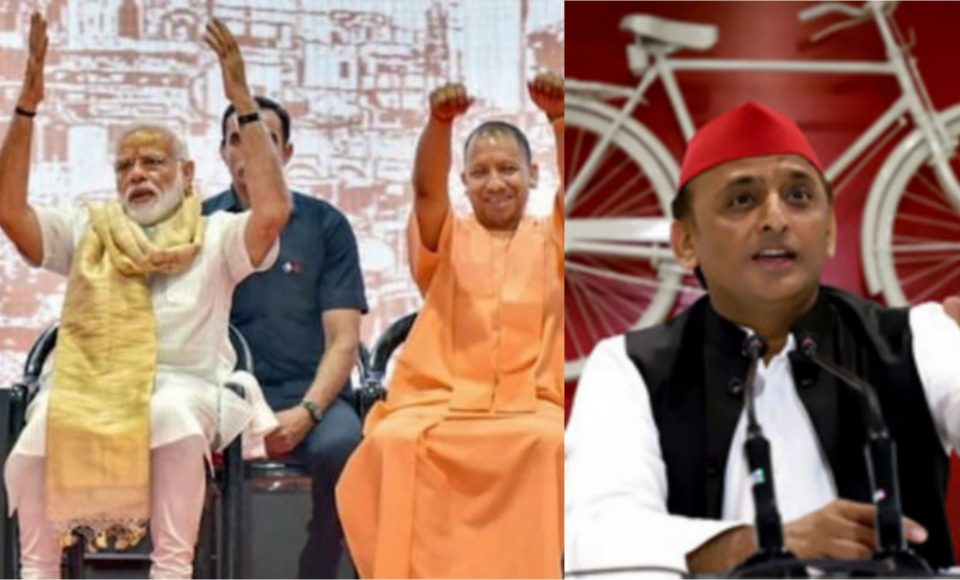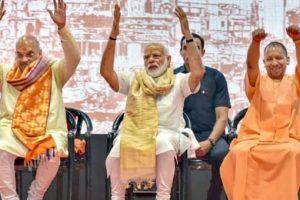
UP voters favour Modi & Yogi, but Akhilesh may see an improbable win
Strong personalities, especially political leaders, always attract hyperbole when it comes to an analysis. Prime Minister Narendra Modi is no different. This time, it revolves around how career defining the forthcoming Uttar Pradesh assembly elections are going to be for him. According to pundits, his electoral battles, whether fought directly or indirectly, have always been crucial ones in his life and career since the 2007 Gujarat assembly elections. This time however, the hyperbole may just be justified.

Strong personalities, especially political leaders, always attract hyperbole when it comes to an analysis. Prime Minister Narendra Modi is no different. This time, it revolves around how career defining the forthcoming Uttar Pradesh assembly elections are going to be for him. According to pundits, his electoral battles, whether fought directly or indirectly, have always been crucial ones in his life and career since the 2007 Gujarat assembly elections. This time however, the hyperbole may just be justified.
Narendra Modi is eyeing a unique record. No Prime Minister other than the late Jawaharlal Nehru has led his party to three consecutive Lok Sabha victories. If Modi can win 2024, his place in history is secure; no matter how much his critics carp and froth at the mouth. But the question is, can he?
Political analysts have always acknowledged that Google Maps must place Lucknow as the starting point if the destination is Delhi. Till 2000, UP had been sending 85 members to the Lok Sabha. It still sends 80. You don’t need to be a genius to figure out that the party which can win the most number of seats in the state has the best chances of forming a government at the centre. A few examples will demonstrate the truth behind the assertion.
In 2004, the charismatic Atal Bihari Vajpayee and the BJP were shocked by an enigmatic and dour Sonia Gandhi, whose Congress unexpectedly won 145 seats in the Lok Sabha, 8 more than the BJP’s 138. In UP, the BJP managed to win just 10 out of the 80 seats.
It was game, set and match for Sonia Gandhi, as non-BJP parties won more seats in the state. In 2009, Congress supporters were pleasantly surprised when the party actually won 206 Lok Sabha seats. It achieved an astoundingly improbable feat of winning 22 seats in UP. We don’t need to repeat how UP has helped Modi ride to power in 2014 and how he repeated the feat in 2019.
Also read: Farm laws climbdown, tomatoes pricey: Does BJP have feet of clay?
When BJP looked invincible

And yet, 2024 is still far away and Modi (along with Chief Minister Yogi Adityanath) have to first jump across the high hurdle of the 2022 assembly elections in the state. Despite the wreckage left behind by the second wave of the coronavirus, it appeared, till a few months ago, as if the UP assembly elections due in February-March 2022, is already in the bag for the BJP.
Party supporters and sympathisers in the media claimed that Yogi Adityanath’s track record of having done some solid development work combined with the usual high-decibel Hindutva rhetoric will ensure another sweeping victory. In contrast, Mayawati, who had ruled the state with an absolute majority between 2007 and 2012, and her party BSP seems to have gone into hibernation after the 2019 Lok Sabha elections.
The Samajwadi Party led by Akhilesh Yadav too looked like it was in a disarray with Yadav making immature statements on the COVID-19 vaccine claiming that he was not going to take that “BJP vaccine.”

We will not get into the details of psephology here, but polls conducted by C-Voter in the state indicate that there is more than a 15 per cent gap between the BJP and SP. In the 2017 assembly elections, the gap was about 20 per cent. So, when Modi addressed the nation from the ramparts of the Red Fort on August 15, 2021, he looked tantalisingly close to matching the record set by Jawaharlal Nehru.
But to repeat a cliché, a week is a long time in politics. And suddenly, against all odds, the SP and Akhilesh Yadav seem to be getting a second wind in this crucial steeplechase.
What happened first was that UP voters seemed to have virtually given up on Mayawati, and this was clearly evident in the C-Voter polls. The second related development, which started unfolding a few months ago, was the complete consolidation of the Muslim votes by the Samajwadi Party. Thirdly, the long-drawn out farmers’ protests too have begun to hurt BJP’s prospects in western UP. Though, the C Voter polls have shown no overall decline in the BJP vote share, significantly, the SP’s vote share has started to climb steadily and continuously.
Also read: Farmers may yet punish Modi for his hubris and arrogance
Resurrection of Akhilesh’s fortunes
It is at this stage that Akhilesh seems to have played what may well turn out to be a master stroke. In 2017, despite the Modi juggernaut, the BJP had allied with a bunch of small sub-regional parties that provided further momentum to the BJP campaign. Akhilesh Yadav too is pursuing a similar strategy.
The former BJP ally and the leader of the Rajbahar community, O.P. Rajbahar, who was a minister in the Yogi government, is now a close SP ally. So is the RLD led by Jayant Choudhary, who claims the support of the dominant Jat community in western UP. This has propelled the projected SP vote share to 33.5 per cent in the state. For Akhilesh, a return to power no longer looks impossible.
But an outright Akhilesh victory still looks improbable at the moment. That is because of the sheer weight of arithmetic against him. Despite the alliances that seem to have propelled his party to an impressive 33.5 vote share, the BJP continues to be 7 per cent ahead at the moment. That kind of vote share gap will virtually guarantee an electoral victory for the BJP, even if the “chemistry” seems to be working against them.
In West Bengal in 2021, Mamata Bannerjee not only had the arithmetic with an almost 10 per cent vote share lead, but she also had the chemistry right with the voters. In Gujarat, in 2017, the BJP had a 10 per cent vote share lead against the Congress. But the chemistry seemed to be wrong and Modi could be seen visibly straining his sinews during the last phase of the campaign. And yet, the BJP won, even though it was a very narrow victory by BJP standards in the state.
Besides, as the graph below (where AY is Akhilesh Yadav) distinctly indicates that Modi is still a bigger factor than Yogi in the state and continues to be miles ahead in terms of performance perception. Added to which, even Yogi is ahead of Yadav and that is queering the pitch for the latter.

Can Akhilesh hope for an improbable victory? The only way that will happen is if the BJP vote share falls by about 5 per cent between now and elections. And, if the SP vote share increases by about 5 per cent.
The BJP vote share can indeed drop if the carefully cultivated rainbow of caste coalitions break. That doesn’t seem to be happening. The other possibility is for unhappy BJP voters (and they are unhappy for many reasons) to stop going to the electoral booth on polling day, just like it happened in the 2004 Lok Sabha elections. Nobody can predict that eventuality.
Chances of BSP chief Mayawati’s core vote bank shifting to Akhilesh looks improbable. Meanwhile, for SP vote share to go up, Congress and BSP votes may have to move towards SP. This happened with the Left and Congress votes in West Bengal, when their votes moved to Mamata Banerjee’s TMC. There is little possibility of further fall in Congress’s vote share as it has already hit rock bottom. But then, who knows what may happen by January 2022, if Akhilesh becomes the winning horse?
Don’t forget, Dalits consider the core supporters of SP as their main oppressors and tormentors in rural UP. The 2019 Lok Sabha elections clearly showed that in the alliance between the SP and the BSP, the BSP voters didn’t vote for the SP, leaving Akhilesh with just five Lok Sabha seats, while Mayawati picked up 10, up from zero in 2014.
Strange things do happen in politics. It would be an extraordinary feat if Akhilesh gets the right chemistry to beat BJP’s arithmetic. For the moment, Modi can continue to dream of emulating Nehru in the 2024 elections.
(Yashwant Deshmukh is the Founder and Editor-in-Chief of C-Voter Foundation and Sutanu Guru is Executive Director of C-Voter Foundation)
(The Federal seeks to present views and opinions from all sides of the spectrum. The information, ideas or opinions in the articles are of the author and do not reflect the views of The Federal.)


